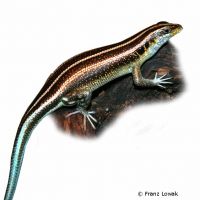African Five-lined Skink (Trachylepis quinquetaeniata)
| African Five-lined Skink Trachylepis quinquetaeniata | |
|---|---|
| Name | African Five-lined Skink |
| Name Lat. | Trachylepis quinquetaeniata |
| Synonym | Mabuya quinquetaeniata |
| Family | Skinks |
| Family lat. | Scincidae |
| Order | Scaled Reptiles |
| Order lat. | Squamata |
| Origin | Africa |
| Habitat | Savanna |
| Diet | Insects, fruits |
| Humidity | 50-60 % |
| Behavior | Peaceful |
| Keeping | Pair, group |
| Care Level | Easy |
| Reproduction | Oviparous |
| Housing | Semi-humid terrarium |
| Life Span | 6 years |
| Protection | No |
| Metric Units | |
| Size | 25 cm |
| Temperature | 25-28 °C |
| Temperature Local | 40 °C |
| Housing Size | 80 x 50 x 50 cm |
| US Units | |
| Size | 9.8" |
| Temperature | 77-82 °F |
| Temperature Local | 104 °F |
| Housing Size | 30" x 20" x 20" |
Distribution and habitat
Diurnal blue-tailed skinks are widespread throughout Africa, except in the extreme south, central Sahara, and rainforest regions. They live in savannas and steppes, often near waterholes. As crop followers, they are often found in settlements
Maintenance
Minimum dimensions for the terrarium, according to the size and number of animals
| 1-2 animals | 6KRL x 4KRL x 3KRL (L x W x H) |
Head-torso length (KRL) is measured on the largest animal. For each additional animal, increase the footprint by 15%. A terrarium of e.g. 80 x 50 x 50 cm is recommended, which should be placed in a quiet and vibration-free place.
You will need a terrarium with roots and stone structures that provide plenty of hiding and shading places, structured back and side walls (e.g. cork covering), a deep burrowable substrate of sand-clay mixture and rubble, as well as a small water container and some drought-resistant potted plants (e.g. succulents). A small portion of the substrate, especially the lower sand layers, should always be kept slightly moist. Once a day, preferably in the evening, the interior of the terrarium should be finely sprayed with water, but not directly the animals
| Temp. day: 25-28 °C | Temp. night: 18-22 °C | Temp. local: up to 40 °C | Humidity: 50-60 |
Thermostatically controlled floor heating is recommended. Lighting duration must be 12-14 hrs depending on the season. They need high light intensity and daily UV irradiation as well as sunny places with radiant heat.
Diet
The diet consists of live insects, such as crickets, house crickets, small grasshoppers, cockroaches, spiders, etc., occasionally supplemented with sweet fruits (e.g. bananas, berries). After habituation, ready-made food for insectivorous reptiles is often accepted. Wax moths should rarely be fed in very small amounts because of their large fat content. Regular addition of minerals and vitamins (e.g. by dusting the food) is important. Young animals should be offered food daily, adults 4-5 times a week. Drinking water must always be available. A regular and varied diet promotes health and prevents deficiency symptoms.
Reproduction and breeding
The females have a black back with cream longitudinal stripes and a blue tail. The males are brown with reddish brown banding
They are oviparous and one clutch consists of 11-12 eggs buried in moist soil. The incubation period is 35-40 days at a temperature of 27-30 °C. The young can be raised in a group. Small insects such as fruit flies, aphids, micro echinoderms, etc. are suitable as initial food. The life expectancy can be 6 years.
Important
They can be kept well in a group and behave somewhat territorial only during the mating season. They are very aggressive towards other species
They need moist hiding places and according to their need for warmth sunny places, such as climbing branches or stones irradiated by a spot
The quality of the food animals can be upgraded by giving them fruit and honey water as food.
The terrarium must have good ventilation without drafts and meet the species specific needs. Measuring devices such as thermometers, hygrometers, etc. are necessary. The lighting has to correspond to the species-specific day-night rhythm and has to be placed in such a way that the animals cannot injure themselves. The terrarium should be locked in such a way that neither unauthorized persons can open it nor the animals can escape. Contamination must be removed regularly
Further literature can be found in your pet store.
References
Text: petdata; Image: Franz Lowak
Source: BMELV (1997): Tierschutzgutachten - Mindestanforderungen an die Haltung von Reptilien; ENGELMANN (2006): Zootierhaltung - Tiere in menschlicher Obhut: Reptilien und Amphibien, Harri Deutsch Verlag
- Gemäß § 21 Abs. 5 Tierschutzgesetz idgF
